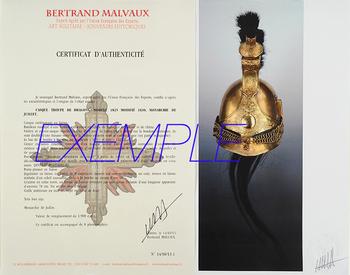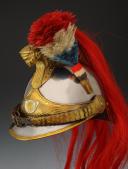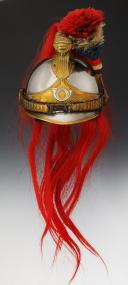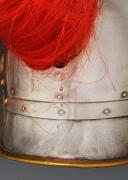
CHASSEUR À CHEVAL STAFF TRUMPET HELMET, model 1910 described in 1913, Third Republic. 27161
Sold out
CHASSEUR À CHEVAL STAFF TRUMPET HELMET, model 1910 described in 1913, Third Republic. 27161
The bomb, in one piece, made of pressed sheet steel. It is pierced at the top with five suction cup holes, the inside of the bomb is varnished black with copal. Hallmarked on the back with the size “58” and the manufacturer “BERNARD FRANCK ET FILS À AUBERVILLIERS”.
Visor in sheet steel lined with a 1.6 cm wide brass rod placed astride the outer edge. The underside of the visor is lacquered green.
The neck cover is identical to the visor with its black lacquered interior.
Brass headband stamped with a radiant sun on a sandblasted background. In the center is a nickel silver hunting horn (height 3 cm, width 4.7 cm).
Each chin strap is made up of 13 copper scales cut alternately with three or two festoons, which decrease in width from the top one, which is 24 mm, to the last, which is only 17 mm. The right chin strap is garnished at its end with a small riveted copper plate to which a buckle also made of copper is attached. At the end of the one on the left there is a similar plate encasing a copper D garnished with a black varnished calfskin strap, part of which is missing. The upper scale of each chinstrap is covered with a movable copper rosette, independent of the chinstrap. It is circular in shape (diameter 4 cm) showing three rushes in relief.
Brass crest composed of two fins, a mask and a covering.
The fins are stamped with palmettes and a net at their upper edge; the lower part forms a scalloped edge decorated with water leaves, fixed to the bomb by means of two screws, all stamped in relief.
A tin-plated sheet metal plate joins the upper edges of the fins, fixing their spacing.
Mask stamped with a Medusa head in relief. The covering, also stamped, represents the continuation of the hair of Medusa's head with intertwined serpents (length 90 mm).
A mane of horsehair, dyed scarlet for the trumpets. It is mounted on a strong embossed cowhide leather sole, it is fixed to the crest by two screws.
Plumet holder in stamped brass, tubular shape with square section, slightly decreasing towards the bottom, H 3.5 cm.
The interior decoration consists of a turban, a cushion and a headdress in glossy black sheepskin, cut into wolf teeth, each decorated with a metal eyelet.
Tricolor rooster feather plume H12 cm mounted on a rib with metal spring in the lower part Total height 18 cm, olive pompom in braided wool, tricolor.
France.
Third Republic.
Perfect state of conservation.
NOTE CONCERNING HORSE HUNTER HELMETS AND HUSSAR HELMETS model 1910:
After numerous hairstyle trials, this model was retained as the regulatory model. Its commissioning will be slow and interrupted by the Great War. It was adopted in 1910 but it was not until September 22, 1913 that its description was published in the Official Military Bulletin.
On April 27, 1910, “La France Militaire” learned that the lightweight dragoon helmet “was being tested in a regiment of horse hunters – the 17th or 18th from Lunéville – and in the 6th a regiment of hussars from Commency”.
In April 1911, the 5th regiment of horse hunters from Châlons took part in the autumn maneuvers wearing the 1910 model helmet.
However, after its introduction, this helmet remained stored in clothing stores as part of the war collection. If eight regiments of hunters received it after the start of hostilities in 1914, only the 5th regiment received it upon mobilization. The closing report of the 1911 trials noted that the helmet was judged to be the ideal headgear for light cavalry. Budgetary appropriations of 66,444 francs in 1913, then 140,000 francs in 1914, were opened for its distribution in seventeen light cavalry regiments, but it would take a year of war for twelve regiments of them to finally receive it. from June 1915 (perhaps thirteen regiments with the 3rd Hussars, written proof is missing but period photos are known).
This helmet never became regulatory for light cavalry officers before the war as evidenced by the absence of description in the April 1914 edition of volume 104 of the BOEM maintaining the shako as orderly headdress. After the opening of hostilities, the helmets issued to officers will be of the troop type, according to the ministerial decision of November 24, 1914.
1 392 / 5 000
Résultats de traduction
Résultat de traduction
On April 22, 1914, the Minister of War declared that he had 3,800 hunter helmets and 1,880 hussar helmets: "these availabilities make it possible to give helmets to five regiments of hunters, to four squadrons or three regiments to six squadrons, and two hussar regiments to four squadrons, and to constitute with the surplus, in the depots of the corps concerned, a reserve of helmets intended to equip the reinforcements. The text adds “the 1st, 5th, 13th (no, it is precisely noted in pencil), 15th and 20th hunters would already be equipped with the helmet. The commissioning of the helmets will make a significant quantity of shakos available, the minister specifies to General Joffre.
The issuance of the helmet continues during the summer in strict accordance with the April details: 2nd and 4th hussars on June 10, 14th hunters on June 23, 10th hunters on July 15 (collected only on July 10, 1915), 13th hunters on July 16, 17th and 18th hunters on July 31. The 8th Hussar Regiment is the only one in its weapon subdivision to have received the model 1910 helmet before August 1914. The 15th Hunter Regiment will receive the helmet on March 11, 1915.
The 1st hussar regiment was equipped with helmets to replace shakos according to a decision of October 3, 1915, according to the Official Military Journal. However, it is most likely the Adrian helmet.
The bomb, in one piece, made of pressed sheet steel. It is pierced at the top with five suction cup holes, the inside of the bomb is varnished black with copal. Hallmarked on the back with the size “58” and the manufacturer “BERNARD FRANCK ET FILS À AUBERVILLIERS”.
Visor in sheet steel lined with a 1.6 cm wide brass rod placed astride the outer edge. The underside of the visor is lacquered green.
The neck cover is identical to the visor with its black lacquered interior.
Brass headband stamped with a radiant sun on a sandblasted background. In the center is a nickel silver hunting horn (height 3 cm, width 4.7 cm).
Each chin strap is made up of 13 copper scales cut alternately with three or two festoons, which decrease in width from the top one, which is 24 mm, to the last, which is only 17 mm. The right chin strap is garnished at its end with a small riveted copper plate to which a buckle also made of copper is attached. At the end of the one on the left there is a similar plate encasing a copper D garnished with a black varnished calfskin strap, part of which is missing. The upper scale of each chinstrap is covered with a movable copper rosette, independent of the chinstrap. It is circular in shape (diameter 4 cm) showing three rushes in relief.
Brass crest composed of two fins, a mask and a covering.
The fins are stamped with palmettes and a net at their upper edge; the lower part forms a scalloped edge decorated with water leaves, fixed to the bomb by means of two screws, all stamped in relief.
A tin-plated sheet metal plate joins the upper edges of the fins, fixing their spacing.
Mask stamped with a Medusa head in relief. The covering, also stamped, represents the continuation of the hair of Medusa's head with intertwined serpents (length 90 mm).
A mane of horsehair, dyed scarlet for the trumpets. It is mounted on a strong embossed cowhide leather sole, it is fixed to the crest by two screws.
Plumet holder in stamped brass, tubular shape with square section, slightly decreasing towards the bottom, H 3.5 cm.
The interior decoration consists of a turban, a cushion and a headdress in glossy black sheepskin, cut into wolf teeth, each decorated with a metal eyelet.
Tricolor rooster feather plume H12 cm mounted on a rib with metal spring in the lower part Total height 18 cm, olive pompom in braided wool, tricolor.
France.
Third Republic.
Perfect state of conservation.
NOTE CONCERNING HORSE HUNTER HELMETS AND HUSSAR HELMETS model 1910:
After numerous hairstyle trials, this model was retained as the regulatory model. Its commissioning will be slow and interrupted by the Great War. It was adopted in 1910 but it was not until September 22, 1913 that its description was published in the Official Military Bulletin.
On April 27, 1910, “La France Militaire” learned that the lightweight dragoon helmet “was being tested in a regiment of horse hunters – the 17th or 18th from Lunéville – and in the 6th a regiment of hussars from Commency”.
In April 1911, the 5th regiment of horse hunters from Châlons took part in the autumn maneuvers wearing the 1910 model helmet.
However, after its introduction, this helmet remained stored in clothing stores as part of the war collection. If eight regiments of hunters received it after the start of hostilities in 1914, only the 5th regiment received it upon mobilization. The closing report of the 1911 trials noted that the helmet was judged to be the ideal headgear for light cavalry. Budgetary appropriations of 66,444 francs in 1913, then 140,000 francs in 1914, were opened for its distribution in seventeen light cavalry regiments, but it would take a year of war for twelve regiments of them to finally receive it. from June 1915 (perhaps thirteen regiments with the 3rd Hussars, written proof is missing but period photos are known).
This helmet never became regulatory for light cavalry officers before the war as evidenced by the absence of description in the April 1914 edition of volume 104 of the BOEM maintaining the shako as orderly headdress. After the opening of hostilities, the helmets issued to officers will be of the troop type, according to the ministerial decision of November 24, 1914.
1 392 / 5 000
Résultats de traduction
Résultat de traduction
On April 22, 1914, the Minister of War declared that he had 3,800 hunter helmets and 1,880 hussar helmets: "these availabilities make it possible to give helmets to five regiments of hunters, to four squadrons or three regiments to six squadrons, and two hussar regiments to four squadrons, and to constitute with the surplus, in the depots of the corps concerned, a reserve of helmets intended to equip the reinforcements. The text adds “the 1st, 5th, 13th (no, it is precisely noted in pencil), 15th and 20th hunters would already be equipped with the helmet. The commissioning of the helmets will make a significant quantity of shakos available, the minister specifies to General Joffre.
The issuance of the helmet continues during the summer in strict accordance with the April details: 2nd and 4th hussars on June 10, 14th hunters on June 23, 10th hunters on July 15 (collected only on July 10, 1915), 13th hunters on July 16, 17th and 18th hunters on July 31. The 8th Hussar Regiment is the only one in its weapon subdivision to have received the model 1910 helmet before August 1914. The 15th Hunter Regiment will receive the helmet on March 11, 1915.
The 1st hussar regiment was equipped with helmets to replace shakos according to a decision of October 3, 1915, according to the Official Military Journal. However, it is most likely the Adrian helmet.
Reference :
27161

Next update Friday, april 4th at 1:30 PM
FOR ALL PURCHASES, PAYMENT IN MULTIPLE CHECKS POSSIBLE
bertrand.malvaux@wanadoo.fr 06 07 75 74 63
An authenticity certificate of the item including the description published on the site, the period, the sale price, accompanied by one or more color photographs is automatically provided for any item priced over 130 euros. Below this price, each certificate is charged 5 euros.
Only items sold by me are subject to an authenticity certificate, I do not provide any expert reports for items sold by third parties (colleagues or collectors).






